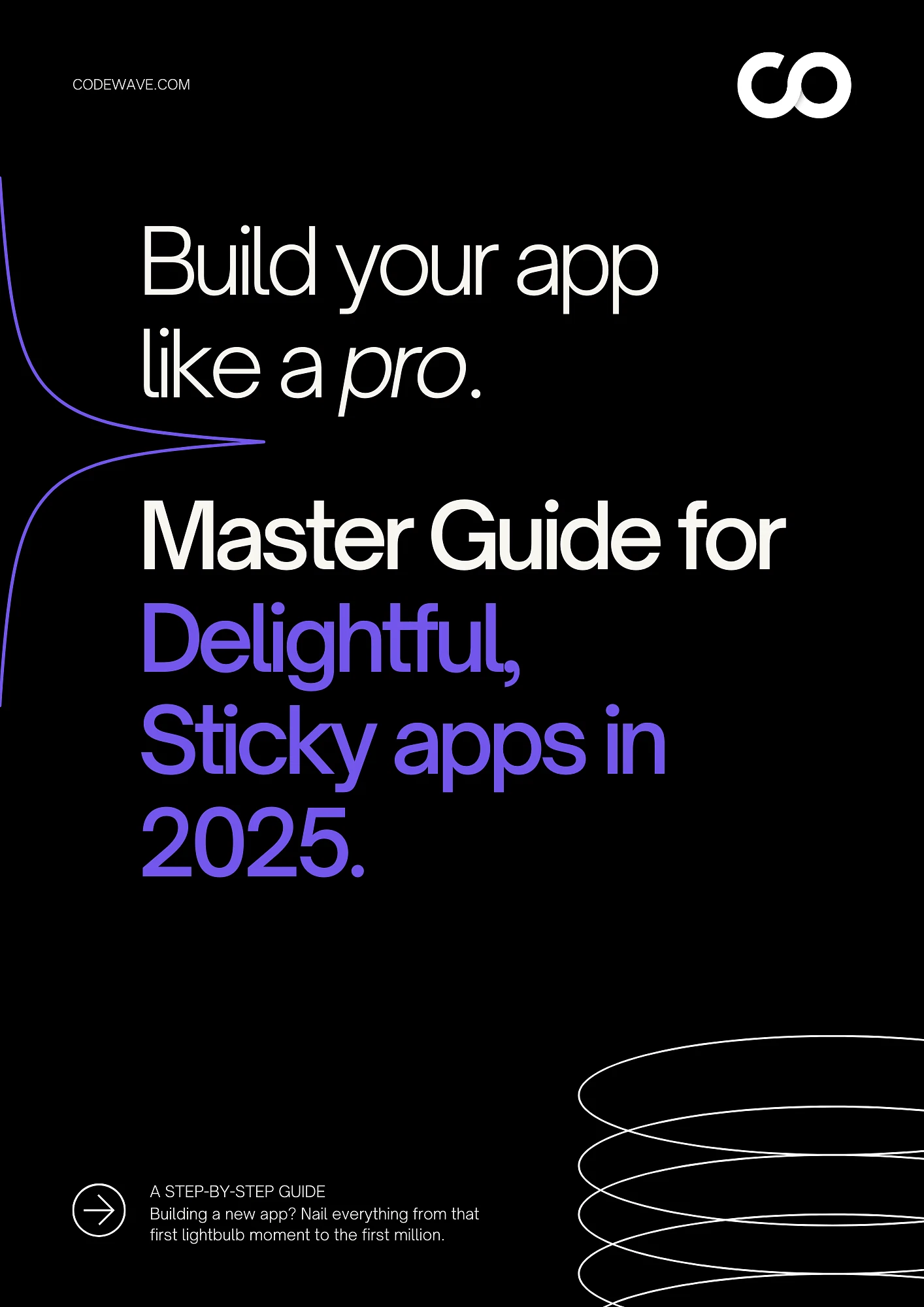Imagine one of your users just downloaded your app, excited to explore what it has to offer. But as soon as they open it, they’re faced with a confusing layout, too many buttons, and a navigation system that leaves them feeling more lost than before. Frustrated, they close the app, never to return.
The reality is that 89% of users abandon apps due to poor performance. And even worse, 13% will share their negative experience with at least 15 people, spreading the word fast.
As an app owner (or soon-to-be one), this is the kind of scenario you want to avoid at all costs. You want users to stick around, enjoy every moment spent on your app, and maybe even become loyal users. That’s why exceptional UX design isn’t just a nice-to-have, it’s essential for keeping your app successful and your users happy.
That’s why, in today’s blog, we’re diving deep into everything you need to know about mobile app UX. We’ll explore why mobile app UX is so important, the key elements that make for a great user experience, and the best practices you should follow to keep users hooked.
Plus, we’ll take you through the design process step by step, and more. Ready to make your app stand out? Let’s get started.
What is Mobile UX?
Mobile UX (User Experience) refers to the overall experience a user has when interacting with a mobile application. It’s about more than just how an app looks—it’s how it feels to use. From the layout and design to the ease of navigation and responsiveness, mobile UX focuses on ensuring the app is intuitive, enjoyable, and efficient for users.
A well-designed mobile UX not only makes an app easy to use but also enhances user satisfaction, keeps users engaged, and builds loyalty. Ultimately, the goal is to create an experience that feels seamless and natural, encouraging users to return time and time again.
Also read: Differences Between UI and UX design – Codewave Insights
So now that you’ve got the basics of mobile UX, let’s dive into why it really matters. Spoiler alert: it’s not just about looking good, it’s about keeping your users happy!
Importance of Mobile App UX
Mobile app UX (User Experience) plays a critical role in shaping how users interact with your app. A well-designed UX not only enhances user satisfaction but also drives retention, conversion rates, and overall app success. With millions of apps available, offering a seamless, intuitive experience can make the difference between gaining loyal users and losing them to competitors.
Here’s why UX is so essential:
- Increased User Retention: A well-designed app with easy navigation keeps users coming back. If users can find what they need quickly and intuitively, they’re more likely to stay engaged long-term.
- Improved User Satisfaction: Simple, fast, and intuitive design makes users feel in control and satisfied. A smooth experience leads to positive reviews and greater brand trust.
- Higher Conversion Rates: An intuitive UX with clear CTAs and easy processes guides users through actions like purchases or sign-ups, improving conversion rates and achieving business goals.
- Reduced App Abandonment: Poor UX, such as slow load times or confusing navigation, leads to high abandonment rates by 25%. A responsive, user-friendly app reduces the chances of users abandoning it after the first use.
- Brand Loyalty: Great UX creates an emotional connection, fostering trust and loyalty. Users who consistently enjoy your app are more likely to keep using it and recommend it to others.
- Competitive Advantage: A smooth, intuitive app experience sets you apart in a crowded market. Users will stick with your app if it solves their problem better and more easily than competitors.
- Positive Reviews and Word-of-Mouth: Satisfied users are more likely to leave positive reviews and recommend your app, boosting your app’s visibility and attracting new users.
Tired of Slow Design Cycles and Guessing User Behavior? Codewave uses AI to speed up design and predict user actions.Discover How We Can Help.
Now that we understand why mobile app UX is so critical to your app’s success, let’s take a closer look at the key elements that make up a great user experience.
Key Elements of Mobile App UX
To create an outstanding mobile app, you need to focus on several key elements that contribute to a smooth, engaging, and effective user experience. These elements form the foundation for ensuring your app is intuitive, user-friendly, and drives long-term success.
Here’s a breakdown of the essential components:
Intuitive Navigation
Navigation is the backbone of your app’s user experience. If users can’t find what they’re looking for quickly, frustration sets in, and they’ll likely abandon the app. A well-designed app should have clear, simple, and predictable navigation that allows users to move through the app effortlessly. Whether it’s a bottom navigation bar, hamburger menu, or tab bar, it’s essential that users feel confident and guided with every interaction.
Responsive Design
Today’s mobile users expect seamless experiences across different devices. Your app must be responsive, meaning it should adjust and adapt to various screen sizes and resolutions without compromising performance. Whether users are on a phone, tablet, or a different device, the experience should feel consistent, fluid, and optimized for the platform. This ensures no matter where they access your app from, users get the best possible experience.
Speed and Performance
These days, users are impatient. Slow load times or laggy performance can quickly turn users off. A fast, responsive app is critical for keeping users engaged and reducing abandonment rates. Optimizing the app’s performance should be a priority, from reducing loading times to making sure interactive elements perform smoothly.
Clear Call-to-Actions (CTAs)
CTAs guide users on what to do next, whether it’s signing up, making a purchase, or completing a task. They should be easy to find, clearly worded, and designed to stand out. A great CTA directs users naturally through their journey in the app, helping to achieve your business goals while improving the user experience.
Visual Appeal and Consistency
A visually appealing design is more than just aesthetics—it plays a crucial role in user retention. Consistent colors, fonts, and imagery help build brand identity while ensuring a cohesive look and feel throughout the app. The design should be clean and clutter-free, with a balance between attractive visuals and functionality. A well-thought-out color scheme can also aid in navigation and influence user behavior.
User Feedback and Interaction
Incorporating user feedback into the app’s design is key to understanding pain points and improving overall usability. This could be through surveys, in-app ratings, or tracking user behavior to identify friction areas. Additionally, providing feedback to the user during interactions (like loading indicators or confirmation messages) makes them feel in control and informed throughout their journey.
Accessibility
Ensuring your app is accessible to all users, including those with disabilities, is critical for offering an inclusive experience. This includes providing options like voice commands, adjustable text sizes, and high-contrast visuals for better readability. An accessible app isn’t just about following legal guidelines—it’s about making sure everyone can enjoy the experience, no matter their abilities.
Minimalistic Design
Users should never feel overwhelmed by an overcomplicated interface. Keeping your design simple, clean, and focused on core functionality allows users to find exactly what they need without distraction. Streamlining the experience by removing unnecessary elements or excessive steps in a process makes the app feel more intuitive and enjoyable.
Best Practices for Mobile App UX
Creating a great user experience doesn’t happen by chance—it’s the result of thoughtful design and continuous optimization. Below are some of the best practices for mobile app UX that will help you create an app that not only meets user expectations but exceeds them:
1. Prioritize Simplicity & Clarity
Users are more likely to stay engaged with apps that are easy to understand and navigate. Keeping the user interface (UI) simple and clear is essential for a positive user experience. Here’s how to achieve this:
- Keeping the interface clean: Remove unnecessary elements, animations, or features that don’t directly contribute to the app’s primary function. Too many distractions can confuse users and make it harder to find what they need. Focus on delivering just the essentials.
- Using straightforward language: Avoid jargon or overly technical terms. Your app’s text should be simple, actionable, and easy for anyone to understand. Clear, concise language improves readability and helps users understand how to interact with your app.
- Limiting choices (Hick’s Law): When users are presented with too many options, they can become overwhelmed and might leave your app. Simplify decision-making by reducing the number of choices at each decision point. If the app requires many options, consider grouping them logically to avoid clutter.
- Maintaining consistency: Use consistent fonts, color schemes, and button styles across the app. Familiarity builds comfort, making it easier for users to learn the interface quickly. Consistency in design reduces cognitive load and speeds up interactions.
2. Optimize Navigation for Effortless Use
Clear and simple navigation is a critical component of UX design. If users can’t find what they’re looking for, they’ll quickly get frustrated and leave your app. Here’s how to optimize your app’s navigation:
- Bottom navigation bars: Many popular apps like Instagram and Spotify use bottom navigation bars because they are within easy reach and provide quick access to key actions (e.g., home, search, profile). This keeps primary functions accessible without overwhelming the user.
- Hamburger menus: While hamburger menus are useful for hiding less important options, they should be used sparingly. Don’t hide critical features or navigation in the menu—this can confuse users who expect everything to be easy to find.
- Breadcrumbs & back buttons: Breadcrumbs (or back buttons) let users retrace their steps easily. They give context and prevent users from feeling lost within the app. These elements allow users to explore deeper content without losing their place.
- Search functionality: A robust search bar is essential for apps with large volumes of content. It allows users to quickly find what they need without scrolling through endless pages or categories. Search is a must-have for content-heavy apps like e-commerce or news apps.
3. Speed & Performance Matter
App performance is one of the most significant factors in user retention. Slow or unresponsive apps lead to frustration, causing users to abandon them. Focus on optimizing performance with these techniques:
- Reducing load times: Optimize your images and media files to reduce load times. Use lazy loading (loading content only when needed) and minimize unnecessary HTTP requests to improve responsiveness.
- Skeleton screens: Skeleton screens are loading screens that show a placeholder structure for content while it loads. This keeps users engaged, giving them a preview of the content to come, which reduces frustration during wait times.
- Offline functionality: Allow users to access certain features even when they don’t have an internet connection. Apps like note-taking tools (e.g., Evernote) allow users to save and edit content offline, syncing data when they reconnect.
4. Design for Thumb-Friendly Interaction
Over 75% of users operate smartphones with one hand. Therefore, ensuring that your app is thumb-friendly is key to making the user experience comfortable and accessible:
- Thumb zone placement: Place key interactive elements like buttons or CTAs in the “thumb zone”—the easy-to-reach area of the screen. This minimizes the need for users to stretch their fingers and enhances the usability of your app.
- Avoid top corners: While top corners may seem like an ideal place for buttons, they’re difficult to reach, especially on larger devices. Keep frequently used features within the lower part of the screen for easier access.
- Large, tappable buttons: Ensure that tappable targets, like buttons or links, are large enough to be comfortably tapped with a thumb. A minimum size of 48x48px ensures that touch targets are easy to interact with, reducing mistakes and frustration.
5. Follow Platform-Specific Guidelines
iOS and Android have different design languages and guidelines, and adhering to them is essential for creating a seamless and familiar experience for users. Here’s how to stay aligned with these platforms:
- Material Design (Android): Material Design emphasizes bold colors, floating buttons, and layers of elevation effects that make the app feel dynamic and responsive. Ensure that your Android app follows these conventions for consistency and user familiarity.
- Human Interface Guidelines (iOS): iOS apps favor minimalist design with subtle animations, translucency, and high contrast. Stick to these guidelines to ensure that your app feels native to the iOS environment and aligns with user expectations.
- Avoid direct ports: If you create an Android app, don’t simply port it over to iOS, or vice versa. The design elements for both platforms are distinct, and a direct copy will likely feel out of place. Instead, adapt the design to fit the unique guidelines of each platform.
6. Provide Instant Feedback
Users want to know immediately that their actions have been registered. Instant feedback reassures them that they’re on the right track. Here’s how to implement feedback effectively:
- Micro-interactions: These are small animations or responses that acknowledge user actions, such as a button changing color when pressed or a small loading spinner appearing when content is being processed.
- Error prevention: Provide real-time validation to prevent mistakes. For example, password strength meters can help users create secure passwords, or real-time checks can guide users on proper form submission.
- Clear error messages: When errors do happen, ensure that your app provides useful, actionable feedback. Instead of generic error messages like “Something went wrong,” explain the problem and guide users toward a solution (e.g., “Password must be at least 8 characters”).
7. Enhance Accessibility for All Users
Over a billion people live with disabilities, and ensuring your app is accessible is not only essential but responsible. Here’s how you can make your app inclusive:
- High contrast mode: Offer a high-contrast mode for users with visual impairments, making text more legible against the background.
- VoiceOver & TalkBack support: Integrate compatibility with screen readers like VoiceOver (iOS) and TalkBack (Android) to support visually impaired users.
- Adjustable text sizes: Provide users the ability to increase or decrease text sizes to accommodate different visual needs.
- Keyboard navigation: For users with motor impairments, ensure that your app is navigable using keyboard shortcuts or an external keyboard.
8. Test & Iterate with Real Users
Assumptions about how users interact with your app can often be wrong. To validate your design decisions, testing is essential:
- Usability testing: Observing real users as they interact with your app can reveal pain points and help you refine the user experience. Pay attention to where users get stuck or frustrated.
- A/B testing: Run A/B tests to compare different design variations, such as button placements, color schemes, or layout choices, to see which performs better in terms of engagement or conversions.
- Heatmaps & analytics: Use heatmaps to see where users click, scroll, or hover the most, and identify areas that need improvement. Analytics can provide insights into drop-off points or areas where users face friction.
Our QA testing processes, powered by Selenium and BrowserStack, ensure the design is both functional and delightful.
Also Read: Top 10 Product Design Companies to Work With In 2024
Let’s turn these proven UX principles into a structured, scalable design process you can actually implement A well-defined Design Process ensures that every aspect of your app is crafted with intention, while Iteration allows you to refine and perfect the experience over time.
The Mobile App Design Process: Steps to Creating a Seamless UX
Let’s dive into the process of designing an app that users will love, and how to continually improve it.
Research & Discovery
Every successful app starts with research. This phase helps you understand your target audience, their needs, behaviors, and pain points. Without proper research, it’s easy to miss key details that could make or break the user experience.
- User Interviews: Talk directly with potential users to gather insights into their needs and expectations.
- Competitive Analysis: Analyze competitor apps to understand industry standards and identify areas where you can improve.
- Personas: Develop user personas that represent your key audience segments, helping guide design decisions throughout the project.
Wireframing & Prototyping
Once you have a solid understanding of your users, it’s time to start sketching. Wireframing and prototyping are essential steps in visualizing how the app will function before diving into the final design.
- Wireframes: Create low-fidelity wireframes to map out the basic structure of the app, focusing on layout and content hierarchy. Wireframes serve as a blueprint for the app.
- Prototypes: Build interactive prototypes that simulate the app’s flow and functionality. Prototypes are helpful in testing concepts before finalizing the design.
UI Design & Visual Style
This is where the look and feel of the app come to life. UI design is about creating an intuitive, aesthetically pleasing interface that reflects your brand identity.
- Visual Hierarchy: Organize elements to ensure that users focus on the most important parts of the app first, using color, size, and placement to guide their attention.
- Consistency: Use a consistent color palette, typography, and iconography throughout the app to maintain cohesion and brand recognition.
- User Interface Components: Design buttons, inputs, menus, and other UI elements with usability in mind. Make sure each component is easy to interact with and provides immediate feedback.
User Testing & Feedback
Testing is crucial to identifying potential issues and ensuring that the app works as intended. Gathering feedback from real users during the design process can help uncover pain points that may not be obvious to the design team.
- Usability Testing: Conduct usability tests with real users to observe how they interact with the app. Focus on any areas where users experience difficulty or confusion.
- Surveys & Feedback: Collect feedback through surveys or in-app prompts to understand how users feel about the app’s design, performance, and features.
Iteration & Refinement
The design process doesn’t end once the app is launched. Continuous iteration based on user feedback and testing is essential for improving the user experience over time.
- Analyze User Behavior: Use analytics tools to track how users are interacting with the app, where they drop off, and which features are most popular.
- A/B Testing: Test different design elements (such as button colors, text sizes, or layouts) to determine what works best for your users.
- Update Regularly: Continuously refine the app based on feedback, analytics, and evolving trends to keep it fresh, functional, and engaging.
Launch & Post-Launch Monitoring
After the initial launch, it’s crucial to monitor the app’s performance and user feedback. This stage helps ensure the app remains stable and delivers the experience users expect.
- Monitor Performance: Keep track of app performance metrics, such as load times, crash reports, and error rates.
- Post-Launch Testing: Conduct additional rounds of testing after launch to identify issues that weren’t caught earlier in the process.
- Iterate & Improve: Continue to make updates and improvements based on user feedback, bug reports, and new features.
Is Your App’s Design Non-Responsive or Inaccessible?
A non-responsive or inaccessible design can drive away users. At Codewave, we tackle this by creating responsive, user-friendly designs that work seamlessly on any device and are accessible to all. Ready for a design that performs across all platforms?
Isn’t it amazing how a good design can make something feel like it was made just for you? Just like Steve Jobs said, “Design isn’t just about looks; it’s about how it feels to use.”
As you work on building an app that not only attracts users but keeps them engaged, it’s crucial to have the right design partner by your side.
Why Codewave is Your Ideal UX/UI Partner?
Is your app design “sticky”? Great UX/UI design goes beyond aesthetics, it drives user adoption and engagement. A confusing interface, clunky navigation, or slow load times can push users straight to your competitors. That’s why Codewave focus on delivering seamless, intuitive, and visually stunning experiences that not only look great but keep users coming back.
Here’s why we’re the right partner for your mobile app:
- User-Centered Design:
Through research methods like user interviews, surveys, and contextual inquiries, we uncover real user needs and craft designs that solve real problems, ensuring your app resonates with users from the start. - Rapid Prototyping for Early Feedback:
We use tools like Figma, Sketch, and Adobe XD to create and refine designs quickly, allowing us to test ideas and gather feedback early, reducing the risk of costly revisions down the line. - Data-Driven Design:
Our designs are based on data, whether it’s understanding drop-off points through Google Analytics, conducting A/B tests, or using tools like Hotjar and Maze for user behavior insights. - Optimized for Engagement and Conversion:
Our UX/UI designs are created to boost user engagement, reduce task completion time, and improve conversion rates. Our clients often see up to a +45% increase in engagement and 2X faster task completion times. - Seamless & Intuitive Interfaces:
We focus on creating intuitive interactions and navigation pathways that make it easy for users to complete tasks effortlessly, whether it’s through card sorting, tree testing, or redesigning navigation. - End-to-End UX/UI Services:
From user empathy and research through to high-fidelity designs and final implementation, we handle it all, ensuring a cohesive, user-friendly experience from start to finish. - Continuous Iteration:
We don’t just stop once your app is launched. Through ongoing user testing, heatmaps, and real-time analytics, we continuously refine and enhance the user experience based on feedback and evolving user needs. - Brand-Centric Design:
Your brand identity is crucial. We create a strong visual language through brand identity workshops and style guides to ensure your app’s design aligns with your brand values and connects with your audience. - Scalability & Flexibility:
Our designs are not only beautiful but also built to scale. As your business grows, we ensure that your app design evolves with it, without the need for a complete redesign.
At Codewave, we work closely with you to create user-centric designs that look great and feel intuitive. See our portfolio to explore how we bring ideas to life.
Ready to see how effective design can transform your product? Partner with Codewave and let’s build a UX that drives success.
Codewave is a UX first design thinking & digital transformation services company, designing & engineering innovative mobile apps, cloud, & edge solutions.







